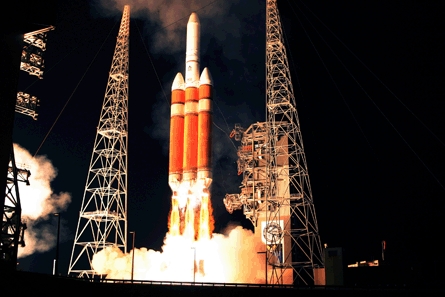NASA's once formidable return to the Moon programme is to be brought back to low Earth orbit as budget realities, technological hurdles and political preferences revive US interest in the International Space Station.
"We were looking at an outpost on the Moonand that one is being revisited. It will probably be less than an outpost on the Moon," NASA acting administrator Christopher Scolese told the US House of Representatives' on 29 April about NASA's goals.
Scolese's comment reflects a recent NASA history of lower than projected budgets leaving the agency with inadequate resources to meet the original goals of former president George Bush's 2020 Moon return, announced in 2004. This lack of funds has led to vocal dissent about the Constellation programme that NASA designed with its Exploration Systems Architecture Study (ESAS) to achieve Bush's Moon return.
Now the new president wants a review of US human spaceflight plans, which he announced on 7 May along with the space agency's fiscal year 2010 budget. US government fiscal years run from 1 October to 30 September.
 |
|---|
© Carleton BailieUSAF EELVs like this Boeing Delta IV are unlikely to launch NASA's Orion |
Beyond a $250 million rise in FY2009 due to president Barack Obama's fiscal stimulus, Constellation's budget is projected to be flat from 2010 to 2014, reflecting the Bush administration's funding reality.
The review has already meant that NASA's Altair lunar lander and Ares V cargo launch vehicle design contracts have been frozen. And the situation may get worse for Constellation's Ares rockets and spacecraft. The human spaceflight review is a technical one, examining Constellation's transport system. But while it will accept data on alternatives, such as the US Air Force's Evolved Expendable Launch Vehicles, ditching Constellation's rockets is not a set goal. Flight International understands that a 2005 Aerospace Corporation report about human rating, which included EELVs, combined with ESAS evidence, is likely to see the USAF rockets ruled out for launching Constellation's Orion crew exploration vehicle (CEV).
Instead, to achieve the existing Orion 2015 maiden flight target, NASA appears to be scaling back the CEV's capabilities. Constellation manager Jeffrey Hanley has said Orion will have a crew of four instead of six and Flight International has documents that show software functions being dropped from early flights. This would ensure software verification can be achieved by 2015.
With reduced capabilities for Orion and a 2015 first flight to the ISS, if NASA were to end its involvement in the station in 2016 the CEV would visit the outpost three or four times and then have nowhere to go.
The man who would make the ISS extension recommendation is the review's leader, former Lockheed Martin chief executive and 1990 US space programme advisory committee chairman, Norman Augustine. Another member of the 1990 review, George Abbey, a former NASA Johnson Space Center director, says that Augustine and his team "made a great case for a space station [in 1990] and why we needed to do research on station to do a lunar, Mars programme".
At the agency's 7 May FY2010 budget briefing NASA comptroller David Schurr said: "As a result of the review, we might see a remix of the prioritiesthe splits between Constellation and Advanced Capabilities may be updated". Advanced Capabilities is NASA's research and development programme for its Constellation vehicles' technologies.
Technologies for the Moon and Mars vehicles could be tested on the ISS. NASA space operations officials said last month that extended ISS use means planning for new procurement contracts has to start soon. Schurr says: "If the decision is made to extend the [use of] ISS, additional investments in spares and batteries may be needed." While ISS assembly completion should happen in 2010, humanity's first permanently manned outpost is set to last beyond the next decade.
Source: Flight International






















